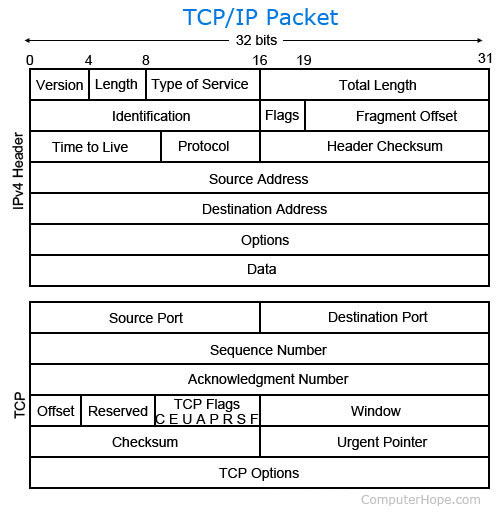TCP/IP
Short for transmission control protocol/Internet protocol, TCP/IP is rules (protocols) governing communications among all computers on the Internet. More specifically, TCP/IP dictates how information should be packaged (turned into bundles of information called packets), sent, and received, and how to get to its destination. TCP/IP was developed in 1978 and driven by Bob Kahn and Vint Cerf.
Example of a TCP/IP packet
Below is a visual example of a TCP/IP packet and the information in that packet. Each of the sections of packet are filled with information that help route the packet to its proper destination.

How does TCP/IP work?
As the name implies, TCP/IP is a combination of two separate protocols: TCP (transmission control protocol) and IP (Internet protocol). The Internet Protocol standard dictates the logistics of packets sent over networks; it tells packets where to go and how to get there. IP allows any computer on the Internet to forward a packet to another computer that's one or more intervals closer to the packet's recipient. You can think of it like workers in a line passing boulders from a quarry to a mining cart.
The Transmission Control Protocol is responsible for ensuring the reliable transmission of data across Internet-connected networks. TCP checks packets for errors and submits requests for re-transmissions if any are found.
Three of the most common TCP/IP protocols
- HTTP - Used between a web client and a web server, for non-secure data transmissions. A web client (i.e., Internet browser on a computer) sends a request to a web server to view a web page. The web server receives that request and sends the web page information back to the web client.
- HTTPS - Used between a web client and a web server, for secure data transmissions. HTTPS is used for sending credit card transaction data or private data from a web client (i.e., Internet browser on a computer) to a web server.
- FTP - Used between two or more computers. One computer sends data to or receives data from another computer directly.
Domain names and TCP/IP addresses
The TCP/IP address for a website or web server is not easy to remember. To remedy this issue, a domain name is used instead. For example, 216.58.216.164 is one of the IP address for Google and google.com is the domain name. Using this method, instead of a set of numbers, makes it easier for users to remember Computer Hope's web address.
What are the different layers of TCP/IP?
There are four total layers of TCP/IP protocol, listed below with a brief description.
- Network Access Layer - This layer is concerned with building packets.
- Internet Layer - This layer uses IP (Internet Protocol) to describe how packets are to be delivered.
- Transport Layer - This layer utilizes UDP (user datagram protocol) and TCP (transmission control protocol) to ensure the proper transmission of data.
- Application Layer - This layer deals with application network processes. These processes include FTP (file transfer protocol), HTTP (hypertext transfer protocol), and SMTP (simple mail transfer protocol).
Computer acronyms, FTP, IP, IPX/SPX, NetBEUI, Network terms, Port, UDP
